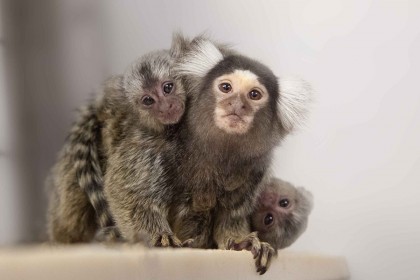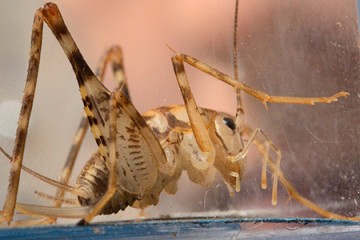Humans apparently aren't alone in the ways we perceive pitch. A new Johns Hopkins study finds evidence that marmoset monkeys share distinct features with humans in the way they distinguish between high and low notes.

Image credit: Yunyan Wang, JHU
The research sheds light on the evolution of vocal communication and song, suggesting that aspects of pitch perception might have developed over 40 million years ago. A summary of the findings was published this week in the Proceedings of the National Academy of Sciences.
Though pitch perception has been found in other animal species, humans have always stood out as unique in their specialized abilities. "Until now, we didn't think any animal species, including monkeys, perceived it the way we do," says Xiaoqin Wang, professor of biomedical engineering at the Johns Hopkins University School of Medicine. "Now we know that marmosets, and likely other primate ancestors, do."
Marmosets, small monkeys native to South America, are known as highly vocal and social creatures. A decade ago Wang and his research team discovered that the monkeys are able to process pitch. They located a region in the marmoset brain where nerve cells "fired" after exposure to sounds with pitch, like a melody's shift from high to low notes. Human brains show similar activity in that region, Wang notes.
What researchers were missing, though, was behavioral evidence that the marmosets could perceive and respond to pitch in the same way humans do. Wang's team spent years developing ways to test that, including training a group of marmosets to lick a waterspout only after hearing a change in pitch.
Those waterspout licks ended up providing solid evidence that marmosets share the three specialized features of pitch perception once thought to be unique to humans. Humans first of all are better at distinguishing pitch at low frequencies rather than high. Second, they're able to pick up on subtle changes in the spread between pitches at low frequencies. And lastly, a person's sensitivity to rhythm appears to dictate their ability to detect pitch differences among simultaneous tones.
Wang says it's possible these specialized abilities with pitch evolved in ancient marmosets over 40 million years ago, remaining present throughout primate evolution until humans inherited them. He says more tests are needed to explore whether the mechanisms evolved in parallel between the African continent and the land mass that split away to become the American continent.
On top of the evolutionary implications of this study, Wang says the doors are open to learn more about human pitch perception "now that we have a primate relative we can study behaviorally and physiologically." Such research, he says, could investigate tone deafness and whether "perfect pitch" is an inherited or learned trait.
Read more from Hopkins MedicinePosted in Science+Technology
Tagged hearing, human evolution, primates










